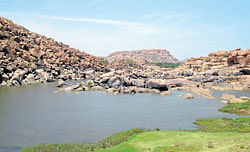While Hampi is a major stop on the tourist circuit, the same doesn’t hold true for Kishkindha. Aruna Chandaraju tours the site of epic importance to show us what we’ve been missing.

Lesser known and much-less-visited than its world-famous neighbour, Hampi, the historic Kishkindha has just as much religious and archeological significance.
Perhaps it is the hot and dry weather which prevails for most of the year, the lack of grand monuments or the rocky terrain – we had a tough time tramping over the stones, pebbles and negotiating dusty tracks – which puts people off.
But Kishkindha’s boulder-strewn landscape has its own magnificence. There is a rugged beauty to this region. A stop at this place can be very rewarding for the pious or those interested in history, literature and rock-climbing.
Kishkindha as well as the whole Anegundi region of Karnataka, with the Tungabhadra river flowing alongside, is associated with one of the most significant episodes in the Ramayana – India’s most-venerated epic.
This region was the Vanara kingdom or the simian empire. It was in Kishkindha that the monkey king Sugriva lived and ruled along with his trusted lieutenants, especially Hanuman, one of the most-worshipped gods of the Hindu pantheon.
This was the site of Lord Rama’s meeting with his greatest devotee Hanuman. This is also said to be the site where Rama made a pact with Sugriva to wage war against Ravana and rescue Sita from captivity. All these episodes are vividly depicted in the section of the Ramayana named after this place – Kishkindha Kanda.
Kishkindha also has a Mahabharata connection. Sahadeva, one of the five Pandavas, is said to have come here to collect tributes for Yudhishtira’s great rajasuya yagna.
According to some legends, Kishkindha is the place where Janamejeya, grandson of Abhimanyu (who was Arjuna’s son and Lord Krishna’s nephew) was enthroned.
Sacred sites
Many sacred spots associated with the Ramayana dot the landscape here – the Anjaneya Hill or Anjanadri where Hanuman was born, the Mathanga Hill, and Rishyamookha Hill where Lord Rama met Sugriva.
The Puranas describe Rishyamookha as the place where thousands of sages meditated and it is therefore considered sanctified by their prayers.
There are many small, forgotten temples and fortifications in the area in and around Anegundi. Megote is one such fortified citadel.
Hucchhappayya Matha temple, with an impressive stone mantapa, was named after the saint who meditated here and is worth a look. You can also check out Nimavanapuram which has a mound of ash which locals believe is the cremated remains of Vali and hence sacred.
Better-known and more-visited are the Anjaneya temple and Ranganatha temples. The former is atop the Anjanadri Hill and is dedicated to Hanuman. There are a great many steps to climb but the faithful willingly take the arduous trek up the hill after bathing in the Tungabhadra!
You also find hordes of monkeys roaming free in this area. Since they are believed to represent Anjaneya, no one shoos them away. In fact, we noticed many tourists and locals reverentially offering them food, mostly plantains.
The Sugriva Guha is where Sugriva lived for many years while in hiding from Vali. It can be reached after walking over a very stony path – god help you if you are not wearing the right footwear.
The Kodanda Rama Temple is a must-see with large idols of Sita, Rama and Lakshmana. A little distance away is the Archeological Museum containing sculpture brought here for preservation from ruins in and around the area, besides a few Neolithic age tools, some weaponry from the 16th century and a floor map of Vijayanagar.
You can drive down to Navabrindavana which, as the name suggests, has nine tombs or brindavans of the Madhwa yathis or saints including Vyasathirtha who preceded Sri Raghavendra.
They are each worshipped on a specific day of the year on which you might find bigger crowds gathering. There was virtually no one when we arrived, but the fierce midday heat of summer was probably the reason.
Cool lakes
A cooler place was the Pampa Sarovar – one of India’s holy lakes. Pampa, a famous devotee, is said to have performed penance at this spot for Shiva.
A small Lakshmi temple as well as some shrines to Shiva, Parvathi and Ganapathi can be found here. If you get to visit the lake in season, you will find it looking very picturesque, abloom with lotuses.
Some distance away, there is another small Ganapathi temple alongside a Jain one. The Chintamani complex is where Lord Rama is said to have come looking for the abducted Sita and where Vali was felled by his arrow.
If you are not into temple-hopping, you can still find lots to do there. There is Elugudda Salu with its prehistoric rock paintings and Morya Mane or Neolithic dwellings while Tara Parvatha (the abode of the queen Tara) is a big draw for rock-climbers.
But these activities are best done during the early morning. We found a group coming down, drenched in perspiration, even before they had completed half the ascent, put off by the searing heat!
Nearby you can see some centuries-old army barracks from the days when Anegundi was a major army outpost. Clearly, there is lots more to see and do in this area here besides visiting Hampi and its celebrated monuments.